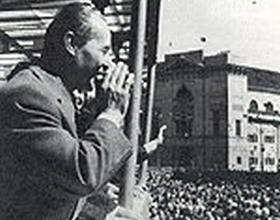


Jeremy Isaacs: Cold War

Måske er den historiske serie, som lige nu kører sit 14. afsnit ud fra DR2 stationens valg og smag for oplysning, et eksempel på, hvad Herzog mener, når han siger, at kendsgerninger skaber normer, men sandheder skaber indsigt.
Afsnittet handler om Krusjtjovs og Dubceks periode, og der er fascinerende arkivmateriale at gense og en imponerende række vidner i interviews fotograferet i den sædvanlige skrå vinkel i det den sædvanlige teatralske lyssætning. Fint nok, kendsgerninger at se og høre, og alt, jeg til nu har sammenfattet om de folk og den tid, bliver bekræftet. Kendsgerningerne normaliserer.
Det er sandhederne, afsnittet mangler. Jeg havde måske ventet, Havel kunne levere dem. Det skete ikke, det lykkedes ham ikke at trænge gennem konceptet. Han, der nok ellers har kunnet undgå at forveksle kendsgerning og sandhed..
Jeremy Isaacs: Cold War 1-24, 1996, afsnit 14: Prags korte forår, DR2 i dag, 18:15. Isaacs skabte i 1973 med The World at War denne særlige model for det storpolitiske tv-epos. www.dr.dk/dr2/Den+kolde+krig http://www.cnn.com/SPECIALS/cold.war/guides/debate/chats/isaacs/






